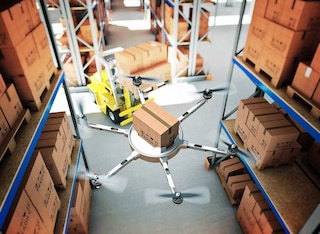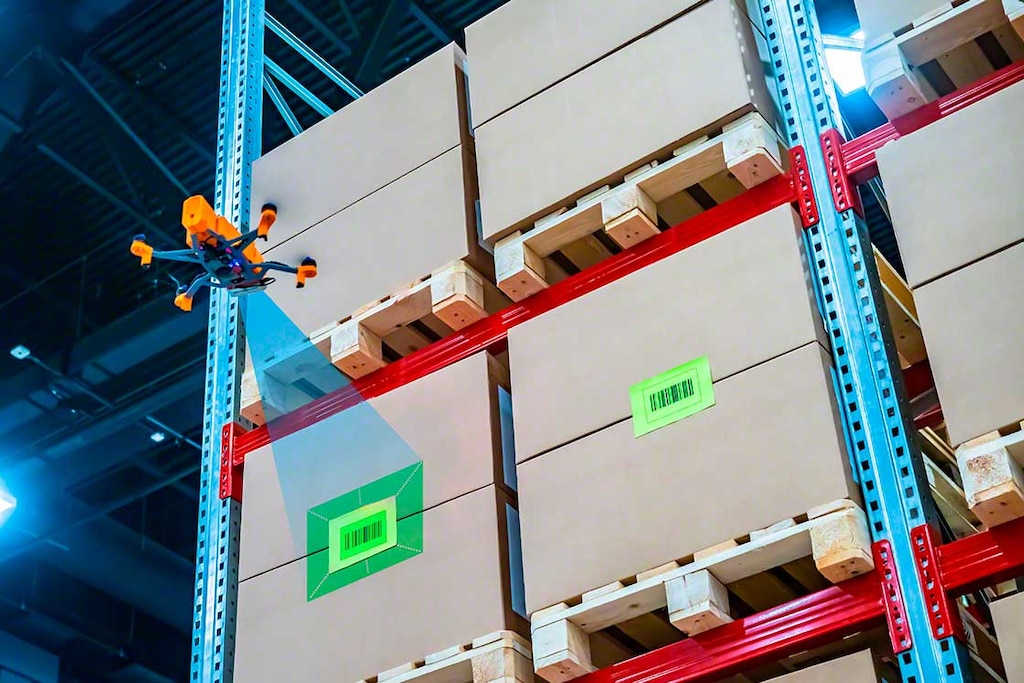
Drones take off in the logistics sector
Drones and logistics are beginning to fly in tandem. With more and more varied applications (from helping to combat fires to making photo reports), drones could lend new functions to warehouses: finding items that are hard to locate, inspecting the upper part of the racks, accessing narrow storage areas, etc.
Moreover, at a time in which same-day deliveries have become the norm, companies are looking for effective solutions that streamline dispatches. There are very high expectations for drones in this sense, as they can transport goods by air, that is, in a much less congested space.
This technology, however, still has several limitations to overcome. In this post, we’ll explore these challenges, the questions raised by the incorporation of drones in installations, and the possible capabilities of drones in the future.
Drones: definitions, applications, and potential
Drones, also known as UAVs (unmanned aerial vehicles), are very small aircrafts operated without the presence of a human pilot onboard. They are normally equipped with four to eight propellers, GPS, and a camera. Drones are not autonomous, since they generally require human supervision: the user steers the course of these devices by means of a remote control. Nevertheless, there are more sophisticated models that can be controlled by a computer or follow a preset route on their own.
The main function of these UAVs consists of moving anywhere required, even penetrating restricted access areas. For that reason, initially, they were used by the military. The fact that they are smaller and more cost-effective than helicopters — as well as unmanned — avoids putting people at risk.
Thanks to the various applications of drones, this technology has already become well-established in multiple industries, such as:
- Energy and infrastructure. With drones, energy companies can monitor the state of all their facilities even though they may be difficult to access (from mines to offshore wind farms).
- Agriculture and forestry. UAVs are used to check crop conditions and detect irregularities. They also track wildlife and spot forest fires.
- Construction. These devices review the progress of construction projects and inspect building damage (for example, following an earthquake).
- Film and photography. One of the most popular drone applications is the making of aerial photo or video reports.
Drones and logistics
Drones have touched down in the logistics sector very recently, and they could become fundamental for the digital transformation of warehouses. This technology will fulfil three specific functions in the supply chain:
Deliver orders
Drones could fly orders to customers. This solution would provide several advantages: decreased costs, faster deliveries, less-congested road transport, and, as a result, reduced pollution.
Although these types of deliveries would be especially beneficial in urban areas, they also have considerable potential in remote, isolated rural areas.
All the same, distribution centres would have to be set up near the customers, as UAVs have limited autonomy. There are also some unresolved issues in terms of drones’ ability to deliver orders: they can’t ring doorbells or enter apartment buildings, they’re sensitive to weather changes, and they can have accidents and fall (which would pose a risk to pedestrians’ safety).
Businesses such as UPS, Amazon, and Google (via its subsidiary Wing) are developing projects related to drone deliveries. To contract this service, customers would have to install an app on their cell phones to track the exact location of the UAV and specify a pick-up point. At the moment, this is still in the experimental phase.
Inspect and monitor the warehouse
Given the difficulty that drones have in moving on public roads, they’re more effective in controlled spaces, such as warehouses.
Just as in other industries, drones could be of great assistance in inspecting the condition of the installation or the racks. These machines are particularly effective when surveying the roof or elevated surfaces in the warehouse (the upper levels of the racks, for example). As this technology evolves, drones could also perform small repairs in areas not so easily accessed by humans.
These UAVs could also act as guards, constituting a new surveillance system and controlling warehouse access. As these apparatuses can fly without interruption for many hours, they can fulfil their roles with the utmost efficiency and without the need for working shifts.
Additionally, by being airborne, they have a much broader view of the installation. Therefore, they could serve to help operators, telling them how to move safely and perform more delicate tasks (moving forklifts in narrow aisles, for example.
Inventory management
One of the most eagerly anticipated functions of drones in the installation consists of quick and effective inventory counting. While it’s true that UAVs really couldn’t replace warehouse workers, they would help them to carry out their tasks more easily.
One of drones’ greatest assets is that they would be able to fly around the facility in a controlled manner, with a flight plan and a predetermined course. They would incorporate cameras to detect their position as well as a goods identification system, be it a barcode reader or an RFID device.
To carry out this job, the UAV would need to be integrated with the warehouse management system. This way, the WMS could carry out very strict control of the SKUs in the installation.
Drones: pros and cons
There’s no doubt that drones will have a positive impact on the supply chain. This is evident even though this technology is still under development, with many applications left to explore and constraints to sort out.
Let’s begin by examining the advantages of drones:
- Speed. UAVs are very fast. The FAA (Federal Aviation Administration), the governmental body responsible for regulating civil aviation, has established a maximum allowable speed of 100 mph for drones.
- Accessibility. In traveling by air, UAVs circumvent traffic restrictions on the ground and show great skill in reaching any destination, as inaccessible as that place may be by land.
- Performance. These devices can fly uninterruptedly for many hours, whether moving a product where required or carrying out an inspection.
- Security. Drones have cameras that record everything that happens while in flight. Hence, companies can be assured that the UAVs arrive at their destination.
It’s also important to take into account some of their drawbacks:
- Legislation. Comprehensive legislation on the use of drones in the airspace has not been drawn up thus far, so air traffic lanes have not yet been defined.
- Cost. The most sophisticated UAVs are still very expensive. As such, they’re inaccessible to many companies. As this technology gains ground, drones are expected to become more affordable.
- Limitations. Depending on the model, drones have a specific load capacity and degree of autonomy. It’s common to find models that carry loads of between 20 and 65 lb. There are plans underway to develop commercial UAVs that can support up to 440 lb.

Drones in logistics: present and future
As with any new technology entering the warehouse, UAVs raise expectations and, at the same time, questions. These devices could move objects and goods very quickly, in addition to penetrating and inspecting areas that are hard to reach. Yes, as of now, their load capacity and autonomy are limited.
Drones represent a change, and if their technology evolves and is adequately developed, they could transform and optimise many supply chain processes. This would compel businesses to improve and modernize their installations, ushering in a new era for logistics.
